Module 11 Body language Revision课件(共21张PPT)
文档属性
| 名称 | Module 11 Body language Revision课件(共21张PPT) |  | |
| 格式 | zip | ||
| 文件大小 | 829.2KB | ||
| 资源类型 | 教案 | ||
| 版本资源 | 外研版 | ||
| 科目 | 英语 | ||
| 更新时间 | 2022-06-04 06:58:01 | ||
图片预览

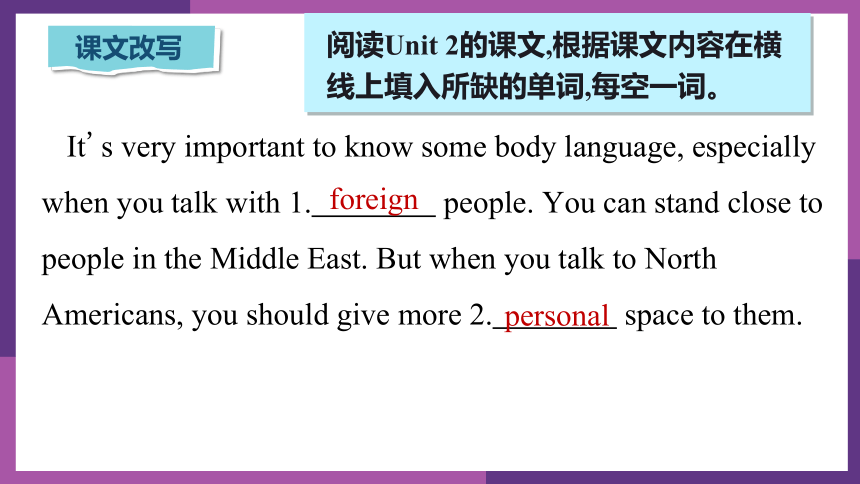
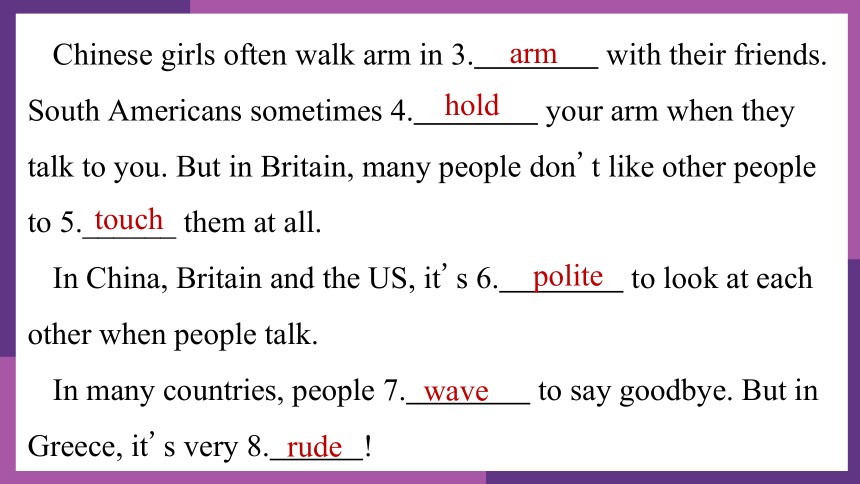
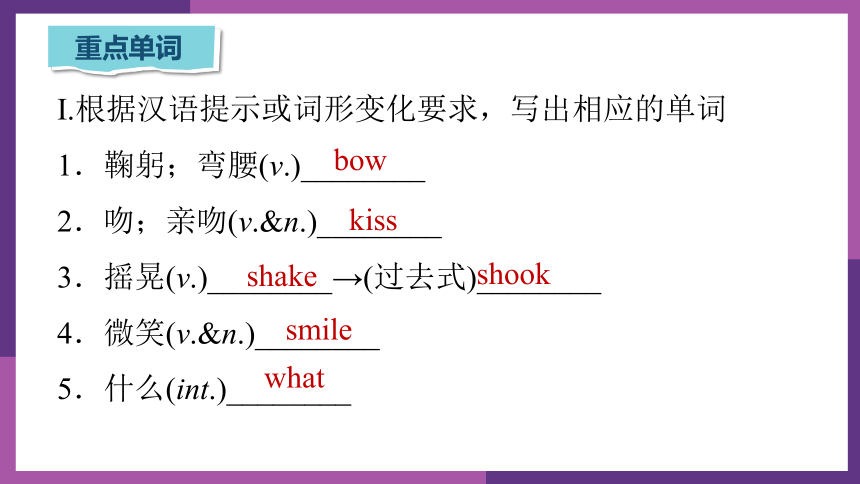
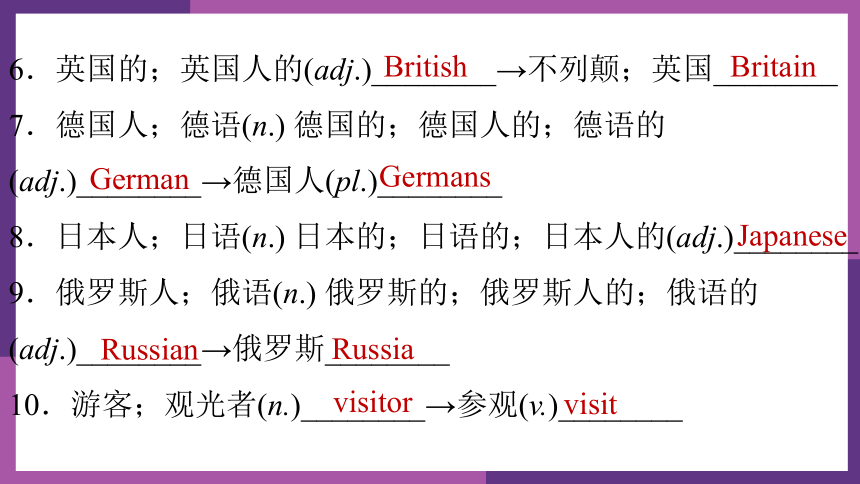

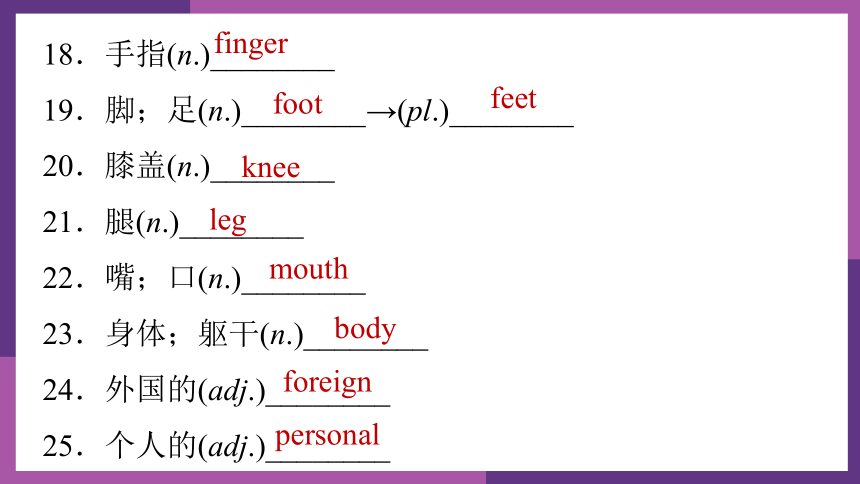

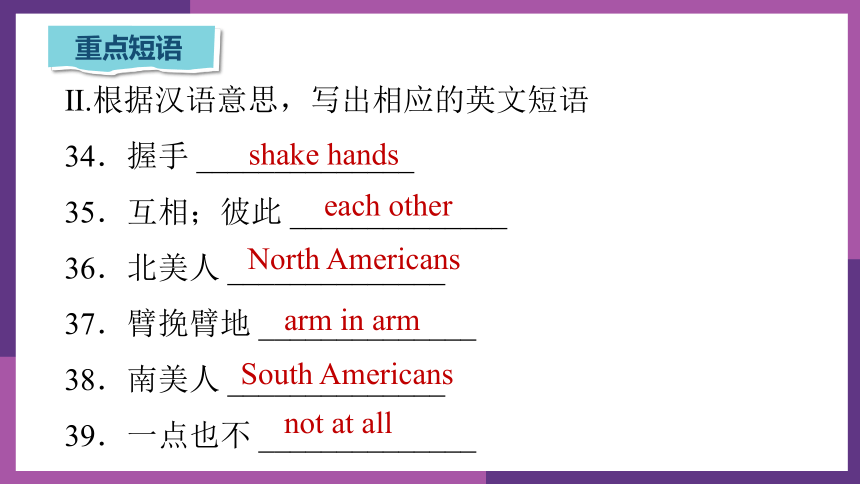
文档简介
(共21张PPT)
Revision for Module 11
课文改写
阅读Unit 2的课文,根据课文内容在横线上填入所缺的单词,每空一词。
It's very important to know some body language, especially when you talk with 1. people. You can stand close to people in the Middle East. But when you talk to North Americans, you should give more 2. space to them.
foreign
personal
Chinese girls often walk arm in 3. with their friends. South Americans sometimes 4. your arm when they talk to you. But in Britain, many people don't like other people to 5.______ them at all.
In China, Britain and the US, it's 6. to look at each other when people talk.
In many countries, people 7. to say goodbye. But in Greece, it's very 8. !
arm
hold
touch
polite
wave
rude
重点单词
Ⅰ.根据汉语提示或词形变化要求,写出相应的单词
1.鞠躬;弯腰(v.)________
2.吻;亲吻(v.&n.)________
3.摇晃(v.)________→(过去式)________
4.微笑(v.&n.)________
5.什么(int.)________
bow
kiss
shake
shook
smile
what
6.英国的;英国人的(adj.)________→不列颠;英国________
7.德国人;德语(n.) 德国的;德国人的;德语的(adj.)________→德国人(pl.)________
8.日本人;日语(n.) 日本的;日语的;日本人的(adj.)________
9.俄罗斯人;俄语(n.) 俄罗斯的;俄罗斯人的;俄语的(adj.)________→俄罗斯________
10.游客;观光者(n.)________→参观(v.)________
British
Britain
German
Germans
Japanese
Russian
Russia
visitor
visit
11.点(头)(v.)________ →(过去式)________
12.拥抱;紧抱(v.)________→(过去式)________
13.头;头部(n.)________
14.各个;每个(pron.)________
15.一起;共同(adv.)________
16.触摸;接触(v.)________
17.鼻子(n.)________
nod
nodded
hug
hugged
head
each
together
touch
nose
18.手指(n.)________
19.脚;足(n.)________→(pl.)________
20.膝盖(n.)________
21.腿(n.)________
22.嘴;口(n.)________
23.身体;躯干(n.)________
24.外国的(adj.)________
25.个人的(adj.)________
finger
foot
feet
knee
leg
mouth
body
foreign
personal
26.臂;手臂(n.)________
27.移动(v.)________
28.握着;使不动(v.)________→(过去式)________
29.礼貌的(adj.)________→(反义词)____________
30.某处;某个地方(adv.)__________
31.挥(手);招(手);摆(手)(v.)________
32.事实;细节(n.)________
33.带来(v.)________→(过去式)________
arm
move
hold
held
polite
rude/impolite
somewhere
wave
fact
bring
brought
重点短语
Ⅱ.根据汉语意思,写出相应的英文短语
34.握手 ______________
35.互相;彼此 ______________
36.北美人 ______________
37.臂挽臂地 ______________
38.南美人 ______________
39.一点也不 ______________
shake hands
each other
North Americans
arm in arm
South Americans
not at all
40.事实上 ______________
41.移开 ______________
42.道别 ______________
43.小心 ______________
44.站得离……近 ______________
45.对……有礼貌 ______________
46.排队 ______________
47.准时 ______________ 48.向……问好 __________
in fact
move away
say goodbye
be careful
stand close to
be polite to
stand in line
on time
say hello to
重点句型
Ⅲ.根据汉语意思完成句子
49.中国人见到来访者的时候经常握手、微笑,有时候点头示意。
Chinese people often shake hands and smile when they ________ ________, and sometimes they ______ ________ ________.
meet visitors
nod their
heads
50.那是因为不同国家的人做法不同。
________ ________ people do different things in different countries.
51.在印度,人们把手合拢并点头行礼。
In India people ________ their hands ________ and nod their heads.
52.给他们更多的个人空间。
Give them ________ ________ ________.
That's because
put
together
more personal space
53.在其他国家,(交谈时)看别的地方是不礼貌的。
In other countries it isn't polite ________ ________ ________ ________.
54.那很简单,挥手道别。
That's easy, ________ ________ ________ _______.
55.当你和朋友交谈时站得有多近呢?
________ ________ do you stand when you talk to a friend
to look somewhere
else
wave to say goodbye
How close
56.在希腊,那绝对是不礼貌的!
In Greece, it's ________ ________ ________ polite!
not at all
In Japan, people bow to say “thank you”, “sorry”, “ hello”, “goodbye”, “you’re welcome”, “excuse me” and many other things. Children and young people bow lower when they greet older people. It’s a way of being polite and showing respect.
Around the world
The Japanese bow
Answer the questions.
1. Do people bow to say “thank you”, “sorry”, “ hello”, “goodbye”, “you’re welcome”, “excuse me” and many other things
Yes, they do.
2. Who bows lower when a young man meets an old man in Japan
The young man.
5
Work in pairs. Talk about different ways of saying hello and body language in China.
shake hands
hug
nod heads
smile
Module task
Write the information on your poster.
6
In China, people often shake hands and smile. Sometimes people nod their heads. But people never kiss. Only parents and children do that.
Find or draw some pictures to add to your poster.
7
Show your poster to the whole class.
8
In China, people often shake hands and smile. Sometimes people nod their heads. But people never kiss. Only parents and children do that.
GOOD JOB
Revision for Module 11
课文改写
阅读Unit 2的课文,根据课文内容在横线上填入所缺的单词,每空一词。
It's very important to know some body language, especially when you talk with 1. people. You can stand close to people in the Middle East. But when you talk to North Americans, you should give more 2. space to them.
foreign
personal
Chinese girls often walk arm in 3. with their friends. South Americans sometimes 4. your arm when they talk to you. But in Britain, many people don't like other people to 5.______ them at all.
In China, Britain and the US, it's 6. to look at each other when people talk.
In many countries, people 7. to say goodbye. But in Greece, it's very 8. !
arm
hold
touch
polite
wave
rude
重点单词
Ⅰ.根据汉语提示或词形变化要求,写出相应的单词
1.鞠躬;弯腰(v.)________
2.吻;亲吻(v.&n.)________
3.摇晃(v.)________→(过去式)________
4.微笑(v.&n.)________
5.什么(int.)________
bow
kiss
shake
shook
smile
what
6.英国的;英国人的(adj.)________→不列颠;英国________
7.德国人;德语(n.) 德国的;德国人的;德语的(adj.)________→德国人(pl.)________
8.日本人;日语(n.) 日本的;日语的;日本人的(adj.)________
9.俄罗斯人;俄语(n.) 俄罗斯的;俄罗斯人的;俄语的(adj.)________→俄罗斯________
10.游客;观光者(n.)________→参观(v.)________
British
Britain
German
Germans
Japanese
Russian
Russia
visitor
visit
11.点(头)(v.)________ →(过去式)________
12.拥抱;紧抱(v.)________→(过去式)________
13.头;头部(n.)________
14.各个;每个(pron.)________
15.一起;共同(adv.)________
16.触摸;接触(v.)________
17.鼻子(n.)________
nod
nodded
hug
hugged
head
each
together
touch
nose
18.手指(n.)________
19.脚;足(n.)________→(pl.)________
20.膝盖(n.)________
21.腿(n.)________
22.嘴;口(n.)________
23.身体;躯干(n.)________
24.外国的(adj.)________
25.个人的(adj.)________
finger
foot
feet
knee
leg
mouth
body
foreign
personal
26.臂;手臂(n.)________
27.移动(v.)________
28.握着;使不动(v.)________→(过去式)________
29.礼貌的(adj.)________→(反义词)____________
30.某处;某个地方(adv.)__________
31.挥(手);招(手);摆(手)(v.)________
32.事实;细节(n.)________
33.带来(v.)________→(过去式)________
arm
move
hold
held
polite
rude/impolite
somewhere
wave
fact
bring
brought
重点短语
Ⅱ.根据汉语意思,写出相应的英文短语
34.握手 ______________
35.互相;彼此 ______________
36.北美人 ______________
37.臂挽臂地 ______________
38.南美人 ______________
39.一点也不 ______________
shake hands
each other
North Americans
arm in arm
South Americans
not at all
40.事实上 ______________
41.移开 ______________
42.道别 ______________
43.小心 ______________
44.站得离……近 ______________
45.对……有礼貌 ______________
46.排队 ______________
47.准时 ______________ 48.向……问好 __________
in fact
move away
say goodbye
be careful
stand close to
be polite to
stand in line
on time
say hello to
重点句型
Ⅲ.根据汉语意思完成句子
49.中国人见到来访者的时候经常握手、微笑,有时候点头示意。
Chinese people often shake hands and smile when they ________ ________, and sometimes they ______ ________ ________.
meet visitors
nod their
heads
50.那是因为不同国家的人做法不同。
________ ________ people do different things in different countries.
51.在印度,人们把手合拢并点头行礼。
In India people ________ their hands ________ and nod their heads.
52.给他们更多的个人空间。
Give them ________ ________ ________.
That's because
put
together
more personal space
53.在其他国家,(交谈时)看别的地方是不礼貌的。
In other countries it isn't polite ________ ________ ________ ________.
54.那很简单,挥手道别。
That's easy, ________ ________ ________ _______.
55.当你和朋友交谈时站得有多近呢?
________ ________ do you stand when you talk to a friend
to look somewhere
else
wave to say goodbye
How close
56.在希腊,那绝对是不礼貌的!
In Greece, it's ________ ________ ________ polite!
not at all
In Japan, people bow to say “thank you”, “sorry”, “ hello”, “goodbye”, “you’re welcome”, “excuse me” and many other things. Children and young people bow lower when they greet older people. It’s a way of being polite and showing respect.
Around the world
The Japanese bow
Answer the questions.
1. Do people bow to say “thank you”, “sorry”, “ hello”, “goodbye”, “you’re welcome”, “excuse me” and many other things
Yes, they do.
2. Who bows lower when a young man meets an old man in Japan
The young man.
5
Work in pairs. Talk about different ways of saying hello and body language in China.
shake hands
hug
nod heads
smile
Module task
Write the information on your poster.
6
In China, people often shake hands and smile. Sometimes people nod their heads. But people never kiss. Only parents and children do that.
Find or draw some pictures to add to your poster.
7
Show your poster to the whole class.
8
In China, people often shake hands and smile. Sometimes people nod their heads. But people never kiss. Only parents and children do that.
GOOD JOB
同课章节目录
- Module 1 Lost and found
- Unit 1 Whose bag is this?
- Unit 2 Are they yours?
- Unit 3 Language in use
- Module 2 What can you do ?
- Unit 1 I can play the piano
- Unit 2 I can run really fast
- Unit 3 Language in use
- Module 3 Making plans
- Unit 1 What are you going to do at the weekends?
- Unit 2 We're going to cheer the players.
- Unit 3 Language in use
- Module 4 Life in the future
- Unit 1 Everyone will study at home
- Unit 2 Every family will have a small plane.
- Unit 3 Language in use
- Module 5 Shopping
- Unit 1 What can I do for you?
- Unit 2 You can buy everything on the Internet
- Unit 3 Language in use
- Module 6 Around town
- Unit 1 Could you tell me how to get to the Nationa
- Unit 2 The London Eye is on your right.
- Unit 3 Language in use
- Revision module A
- Module 7 My past life
- Unit 1 I was born in a small village.
- Unit 2 I was born in Quincy.
- Unit 3 Language in use
- Module 8 Story time
- Unit 1 Once upon a time….
- Unit 2 Goldilocks hurried out of the house.
- Unit 3 Language in use
- Module 9 Life history
- Unit 1 He left school and began work at the age of
- Unit 2 He decided to be an actor.
- Unit 3 Language in use
- Module 10 A holiday journey
- Unit 1 What did you do?
- Unit 2 This morning we took a walk.
- Unit 3 Language in use
- Module 11 Body language
- Unit 1 They touch noses!
- Unit 2 Here are some ways to welcome them.
- Unit 3 Language in use
- Module 12 Western music
- Unit 1 It's so beautiful!
- Unit 2 Vienna is the centre of European classical
- Unit 3 Language in use
- Revision module B
